June 6 marks the 74th anniversary of the Normandy invasion in 1944. At that time, it was the largest invasion in human history. It was a pivotal moment in time. Thousands of young Americans landed on Omaha, and Utah beaches. British landed on Gold and Sword beaches, and Canadians landed on Juno. Thousands more parachuted or were delivered by glider behind the beachheads to take objectives inland. The fate of the world was on their shoulders. This article is intended to detail some of the weapons used by those men as well as the men they faced.
RIFLES
The primary weapon of the infantryman is the rifle. Yes, at this time there were also submachine guns, pistols, anti-armor weapons, and machine guns. But these weapons were all intended to support the rifleman as he took or held ground. Interestingly enough, most of the armies in the Second World War were using either the same rifle their fathers carried in the First World War or a variant thereof. The US Army’s M1 was the exception. Issuing a bolt action left the Germans at a firepower disadvantage in comparison to the Americans they faced. They compensated for this by issuing a larger proportion of automatic weapons. Paratroop units, as well as some other specialty units, tended to have specialty weapons or issue weapons differently than did line infantry units. Examples of this would be the British Paratroops almost exclusive use of the Sten Mk V, M1A1 Carbines in use by US Paratroops, and Mauser 33/40 carbines used by German Gebirgsjagers (Mountain Troops).
American

The US Army primarily equipped its riflemen with, “Rifle, Caliber .30, M1”. The M1 was intended to replace the 1903 Springfield rifle. It was chambered in the same 30-06 round that the Springfield used. The M1 loading was a 150gr FMJ at 2750 feet per second. The APM2 armor piercing load, with a 165gr projectile at 2715 feet per second, was very widely used during the war. The M1 was fed with 8round clips, which most of you are probably aware were not exactly ideal. There is not a particularly good way to “top off” an M1 that isn’t totally empty. But it was still a huge leap forward in terms of the firepower the American Infantryman had at his disposal.
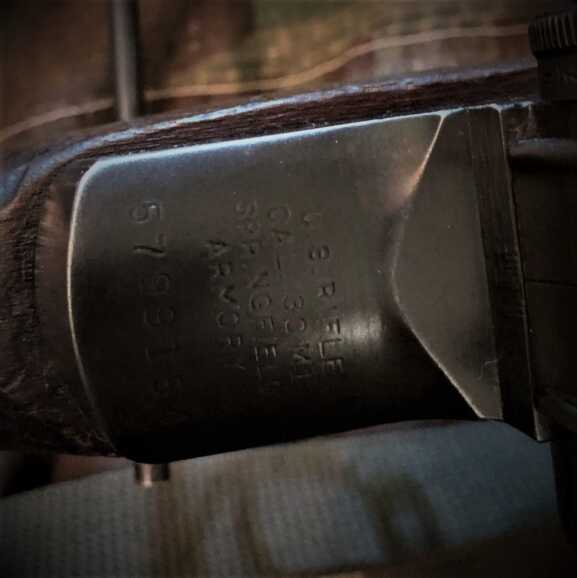
This particular M1 was produced post-war by Springfield Armory. The date on the barrel is January of 1955. I obtained this rifle through the Civilian Marksmanship Program a number of years ago.
The venerable 1903 Springfield rifle was still in service on June 6, 1944. There were a few different variants in service. There was the standard model 1903, the 1903A3, and the 1903A4. The standard Model 1903 was the same rifle used in the First World War. The “03’ Springfield” was designed in the aftermath of the Spanish American War. Really, it’s just a modified Model 98 Mauser and the US government was forced to pay royalties to Mauser for each 1903 made until the First World War came along.
The Model 1903A3 was developed during World War II to ease production time and cost by using more “modern”(for the time) stamped parts, and by using a 2 groove barrel.
The Model 1903A4 was a sniper’s rifle. These were modified from 1903A3 rifles. The iron sights were removed, and a scope was added. Iron sighted 1903s remained in service alongside M1s as the grenade launching attachment for the M1 took some time to become available. Keep in mind, the M1 was still pretty new at the beginning of the war. This is why some units fighting the early battles in the Pacific theater were still using 1903s.
The M1 Carbine was developed to replace some 1911 handguns. It was intended for mortarmen and other troops that would need more than a handgun, but something less unwieldy than a full-size rifle. It ended up seeing much more use than that. Its light weight and 15rd magazine (30 rd mags for M1 Carbines weren’t yet being used in June of 1944) made it very popular during WWII. Most of the complaints about the carbine’s lack of effectiveness didn’t seem to show up until the Korean War, 6 years later. It is chambered in the .30 Carbine round, which pushes a 110gr round nose bullet at around 1950 feet per second. The M1A1 was a folding stock model, intended for use by paratroops, and it saw heavy use during the Airborne operations of the Normandy invasion.

My personal example of the M1 Carbine was produced commercially, as I have yet to add a GI issued example to my collection yet. At least it’s pretty close.
British
The British Army’s rifle was the Short Magazine Lee Enfield. The Lee-Enfield rifle originally went into service in 1895.
It went through a number of changes between then and 1944, but it was still a .303 bolt action rifle with a 10 round magazine. The No. 4 Mk I is typically regarded as the WWII model, but the No.1 Mk III was also used. Both have a 10 round detachable magazine but are intended to be fed from 5 round stripper clips. The No.4 Mk I had a number of changes from the No.1. It had an aperture rear sight and a slightly different fore end. They are both chambered in the .303 British.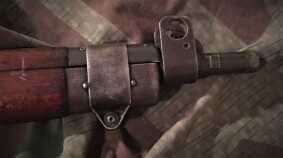
The .303 loading was a 174gr FMJ bullet at around 2450 feet per second, which was essentially the same load they had in 1914. Something to consider for reloaders is that the chambers in these Enfield rifles were cut “rather generously” to ensure reliable operation in combat conditions. So brass life for these is quite short unless you neck size only. Enfield rifles are considered to be some of the best bolt action combat rifles of the time. Their very quick bolt throw, along with their 10 round magazine allowed British soldiers to have a rather impressive rate of fire for a bolt action.
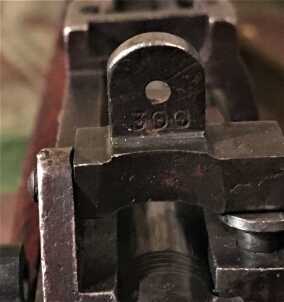
German
The K98 was the standard arm of the Wehrmacht during the war. In essence, it was just a shortened version of the Gewehr 98 that was used in the First World War, and similar to the carbines that were in existence then. It was chambered in the 7.92×57 cartridge (AKA 8mm Mauser), just like the GEW 98. However, the actual loading of the cartridge had changed. The 7.92mm ammunition being used in World War II, used a 198gr FMJ bullet as opposed to the 154gr loading used in World War I. Basically, a “long-range machine gun” round had been developed towards the end of WWI, and it was decided to use it in rifles as well.

This particular K98 was produced in 1940. It was one of the “Russian Capture” rifles imported some years back. The story goes that these weapons were captured from the Germans on the Eastern Front. After the war, the Soviets basically mothballed them, just in case of another major war. After the end of the Cold War, these were surplus and imported into the US.
HANDGUNS
Handguns were intended to be secondary weapons. Typically, they were issued to machine gun or other weapons crews and officers. But there were some units that issued more of them. The 82nd Airborne Division issued large numbers to their paratroopers. The German Fallschirmjager were also fairly handgun heavy because when they jumped their rifles and other weapons were dropped separately in canisters. As such, they needed to be able to fight to their long arms when they landed. The Germans pressed into service a number of “non-standard” handguns that they occupied the factories which had produced them (such as the FN factories in Belgium and their Hi-Power), or handguns that they captured larger quantities of. The Allies also had a number of “secondary” standard handguns as well. So, there were a lot of different models in service between the Axis and Allies on June 6, 1944.
American
The American sidearm in 1944 was, obviously, the Model 1911A1. The history of John Browning’s most popular handgun design has been written many times before, so I’m going to keep it short here. The original model 1911 had served very well in WWI. But it did have a few flaws. So, the Model 1911A1 was introduced in 1926, an improved Model 1911. It featured an arched mainspring housing, longer safety tang, trigger finger cutouts, fully checkered grips, and other minor modifications. 1911A1s were produced by a number of entities during the war. The 1911A1 was highly regarded by the men who used it.
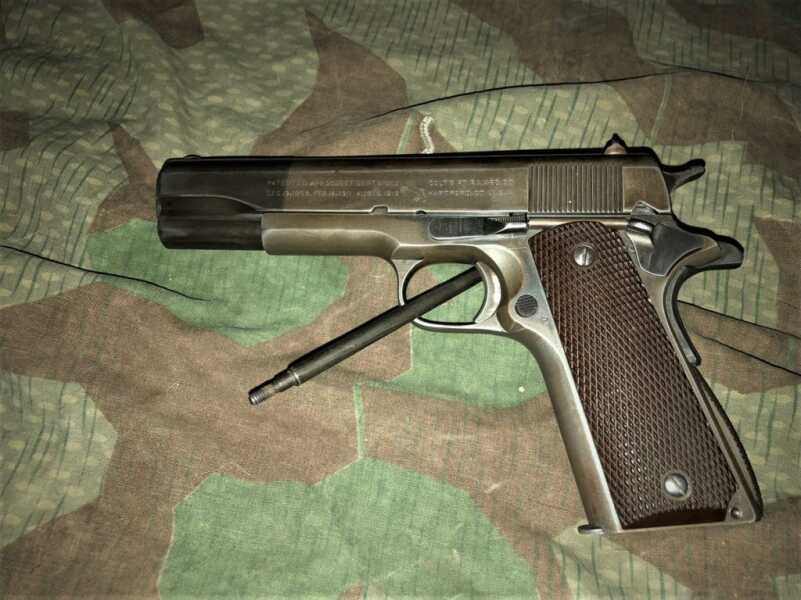
This particular example was produced by Colt. The serial number places its date of production as 1942.
British
The British handgun was rather archaic in comparison, 6-shot revolver. It was the Enfield No. 2 MkI revolver in .380/200 British, which was something of a special loading of .38 S&W.
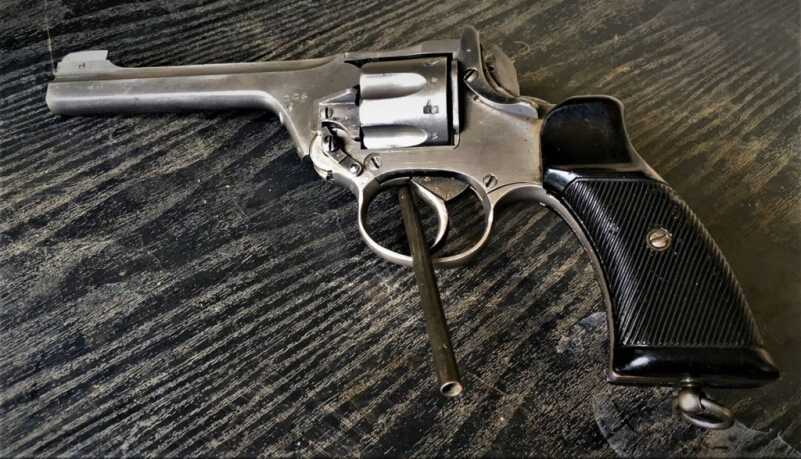
This particular example is an Enfield No. 2 MkI*, and they were intended for tank crew. The hammer spur was omitted to ensure that it didn’t snag as crew members were entering or exiting their vehicles. Without the hammer spur, it was decided to also delete the single action notch on the hammer. As such the No. 2 Mk I* was double action only.
The Enfield was mechanically similar to the earlier Webley revolvers and indeed Webley & Scott had been involved in its design. It was a top break, auto ejecting design just like the Webley.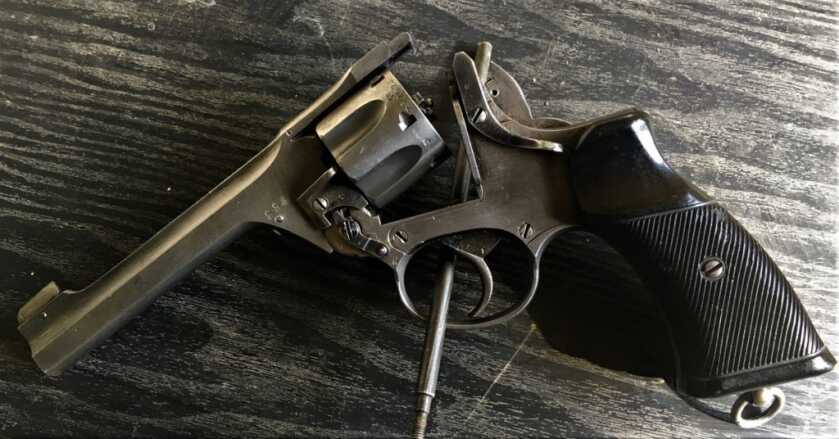
The idea was to replace the older .455 Webley revolvers with something easier to shoot, while not making large sacrifices in the performance department. As such, the .380 British loading is pretty heavy for caliber with the WWII loading at 178grs. Earlier loadings used lead bullets and were closer to 200grs, which is obviously heavier than your average .38 caliber loading. Some legal concerns regarding the use of lead bullets in combat ammunition pushed the Brits to go to the 178gr FMJ load. Velocity of this load was approximately 630 feet per second. Webley also produced revolvers in this cartridge for the British government, as did Smith and Wesson. If you happen to own any of these revolvers, you can shoot .38 S&W ammunition in them. If you reload, there are bullets(or molds if you prefer) that mimic the British loadings, if you are so inclined.
German
While officially replaced in 1938 by the Walther P.38, the P.08 Luger pistol was something of a status symbol for the Germans and was widely used in the Second World War. Though generally considered a World War I pistol, the Germans actually produced it all the way into 1945. This is pretty surprising given the amount of work required to make them. Lugers use a lot of close tolerance parts that have to be hand fit, which makes them difficult to produce. This caused some problems in the conditions of WWI trench warfare. It was chambered in the 9mm Parabellum (AKA 9mm Luger) cartridge and was, in fact, the first 9mm handgun. It was also one of the first autoloading pistols to be invented. The Luger uses a rather unique short-recoiling, toggle-action. Despite its rather awkward appearance, the Luger is actually pretty accurate for a combat handgun (likely due to those close fitting parts) and points very naturally. Magazines for the Luger hold 8 rounds.
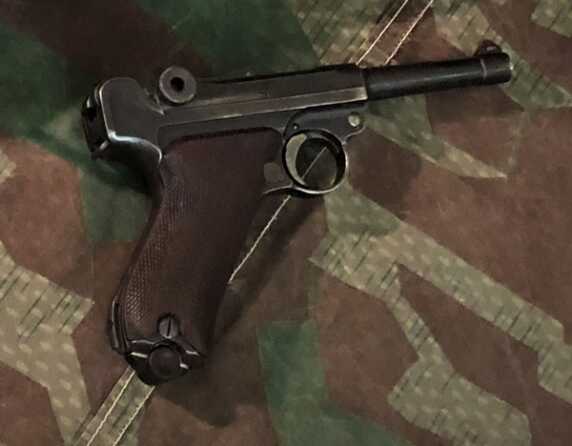
This particular P.08 was made in 1917 at Erfurt arsenal. This makes it WWI issue. There are some Lugers with a “double date”, which means they were likely issued in both world wars.
June 6, 1944, was an important day in history. Thousands of young men landed in France by boat, glider, and parachute and employed these weapons. A lot of them did not survive. It’s hard to imagine now, but they didn’t know that they would ultimately prevail. It was very possible that the entire operation could have been a disaster. The D-Day invasion marked the beginning of the end of Nazi occupation of Europe. The free world owes its existence to those brave men.
***Shop GunsAmerica for your next military surplus firearm***

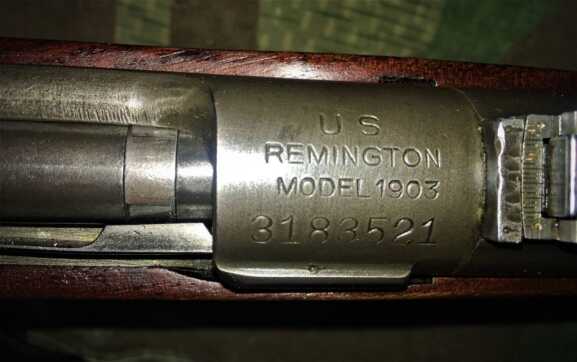


I was just looking at a used luger the other day. I do not remember the company logo that made it, but it had a double year stamp, 1918 and 1920. Any significance of these two dates for the stamps?
My uncle died in a Sherman in Normandy in 1944. Command Tank gunner. I would love to know what arms the US tank crew were issued for battle. I assume that each crewman had a .45, and I was told by a vet that each tank had a Thompson .45 on hand. Any info here, much appreciated.
http://www.theshermantank.com/tank-accessories/the-small-arms-of-the-us-army-tanker-what-they-were-issued-and-what-they-carried/
There’s a lot of generalizing here. Of course, not all millennials are lazy and worthless just like all older white men are crusty and fly confederate battle flags proudly in their front yards. And these yards are in northern states. Talk about not understanding history!
Along with the questionable inclusion of opinions from unverified sources, another failure; the omission of a very widely issued weapon among both the Americans and British – the M1928A1 Thompson sub-machine gun.
I don’t disagree with some of the comments expressed about the millennials. However, as a Vietnam Era vet who volunteered to go to Iraq and then Afghanistan I can say with all confidence that, at least in the military, there were many standup young soldiers. More than I would like to see fell into the “it’s all about me” category. I would also submit that leadership should be the ones to at least introduce young soldiers to the true sacrifices that were made by WW2 and Korean War soldiers. I found that most of the current leadership in 2007-2008 in Afghanistan were very limited in their knowledge of both conflicts.
“The M1 was fed with 8round clips, which most of you are probably aware were not exactly ideal. There is not a particularly good way to “top off” an M1 that isn’t totally empty.”
You don’t know what you are talking about. First off, anyone who is competent with a Garand can keep it firing at the same rate as a magazine fed rifle; but be a lot closer to the ground in a prone position than the novice with a 30 round mag. and has a rifle that has infinately more range and packs one hell of a good punch.
Secondly and good rifleman of the day knew how to top off a Garand by opening the bolt and keeping the opposing thumb down on the remaining rounds in the enblock clip, then adding additional rounds. That method was used at the National Matches at Camp Perry for years.
Next you’ll bring up the 8th round “ping” that would get the operator overrun because “Jerry” knew he was out of ammo. That’s also another B.S. story spread by REMF’s on their return home to help the panties fall off their female companions. Don’t believe me? You lay down 10-15 yards away from me and then get up and charge me when you hear the “ping” and I’ll let everyone know how you made out. (Now to make it even worse, imagine I’m there with eleven other fellows we call an Infantry Squad and they’re all armed and ready to protect me as well.)
A lot of the conventional wisdom on these subjects is B.S. misinformation spread by support troops who came home telling “War Stories”, NOT by the Troops who saw hard combat (the latter tend not to run their mouths very much post conflict).
As a Gun Writer please take the responsibility of knowing what you are talking about before making bold statements on the deficiencies of “the greatest battle implement ever devised”.
He said there was no particularly good way to top off an M1 clip, he didn’t say it was impossible. What you described wouldn’t be considered particularly good in a combat situation.
John, not to be an ass BUT, having actually been in combat and talking in depth to older Vets who used the Garand I can attest they would generally top off a enblock AFTER a firefight should they so desire. Every one of them could do it effortlessly without looking. During an actual firefight one would simply slap in another clip as needed and top off an enblock only when the party was over.
Topping off an enblock to an experienced M1 Rifleman is equal in ease and practicality as removing a partial mag and inserting a fresh one (as you still need to stow the partial mags and eventually consolidate the rounds from the partial mags to make full mags).
If you or the author think it is particularly awkward or difficult to top off an enblock clip it speaks more to lack of experience, training and practice.
I’m not saying the Garand is the best design out there…BUT if I had to rely on an M1 eighty plus years after it was first issued I wouldn’t feel outgunned by any other military rifle of today that was using iron sights… just my 2 cents.
I have never heard of topping off the internal mag of an M1and I know lots of old salts who used them at Camp Perry and DCM/CMP matches. I know quite a few old timers who used them in combat too.
By the way, it is “enbloc” not enblock. Neither have I ever heard anyone, let alone an authority refer to the clips as mags as you do. In addition, as I have an enbloc clip right here, anyone can try this and discover that if you have less than five rounds left in the enbloc, when you trigger the clip ejector the rounds are loose and the clip and rounds come out in a mess, most likely landing all over the ground. The G43 and FN 49 internal magazines have it all over the Garand and can be topped off easily with no mess or M1 thumb.
Jake, that’s because you misunderstood the statement. When I was talking about mags, I was referring to conventional magazines- as in 20 or 30 round magazines in an M4 and was attempting to convey that an experienced M1 Rifleman can top off an enbloc clip as fast as a modern rifleman can perform a tactical reload with a modern magazine (due to the partially loaded modern magazine’s need to be stowed as opposed to being left on the battlefield), sorry if I didn’t go into enough detail for you.
If you utilize the proper technique, there is not much difference topping off a Garand than topping off a G43 or FN49 (if you are not using a stripper clip for the latter two); however the empty Garand would be much smoother and quicker to reload than a rifle that requires a stripper (especially in the prone position). As for “M1 thumb” it is generally due to a lack of experience, training and practice.
As for the old timers you talked to, there were quite a few men out there who fought in WWII and Korea but for every Riflemen there are an average of nine soldiers in support. So while it certainly doesn’t diminish their valor or contribution, it definately makes a huge difference in weapon handling skills and personal experience.
In closing thank you for correcting my spelling error, on that point I wholeheartedly agree with you.
You are talking about those kids born in the ’80s and ’90s. You know, the ones that joined the military after 9/11 and fought and died in Iraq and Afghanistan. And they are still there, still fighting.
The reason they are still there is our leadership does not know how to fight a war. All they know are “Police Actions”.
Many thanks to the brave men and women who serve to protect their country. Too much time has passed for most of the current generations to remember those who gave their lives to preserve their freedoms. Thanks for reminding us.
I had a friend who was with the engineers in Europe in WWII. He would not give you 2 cents for a carbine. He said you had too shoot several times to stop someone and picked up a Garand as soon as he could.
Actually, Germany stopped manufacturing/issuing the P08 Luger in 1943. Of course, with as many issued to the troops they were present on June 6th 1944.
The generations of today don’t care about the past. They don’t care about anything other than themselves. What the world owes them, what they can get from you or me . They are totally spoiled and selfish. They don’t want to work for a living, and prefer to let someone else pay their way. They would rather change history to suite their desires, such as the destruction of the civil war monuments. They are a shame to this country and society allows it. The veterans see it, most of the baby boomers see it. This country is falling apart because of it.
Had it not been for the youngsters flying Hurricanes and Spitfires for the Royal Airforce (and the Kiwi directing their operations) in 1940, there would have been no England for US and Canadian troops to prepare for the invasion of Europe. If Hitler had succeeded in invading the UK, the war would have been extended by at least 2 or 3 years, giving the Germans time to develop the ability to bomb the US with long range, possibly nuclear weapons. The UK invasion would have delayed or even cancelled the fateful invasion of Russia, though that was Hitler’s pet project. It is conceivable that we would now all be speaking in German, though not able to write anything on internet forums. Hitler had fairly good health despite his pharmaceutical regime, and could have remained world dictator for another two or three decades. All subsequent generations owe everything to the generation who stepped ashore in Normandy. I wonder if the millennials realise this.
“I wonder if the millennials realise this.” You’re kidding right? No millennial I’ve ever met gives a shit about anyone but themselves. And, that includes ROTC me-llennials.